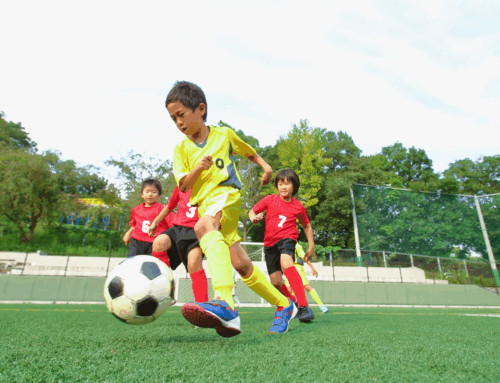Get our exclusive report. Download the iSport360 Club Switching Report Here – For Club Admins, Rec Leaders and Coaches.
Top 2 Sports Training Myths

By Jay Vincent in MVP Parent, January 8, 2021
Since the early 1970s when professional sports organizations and universities began to realize the importance of strength training for injury prevention and performance improvement, we have been continually inundated with the latest “breakthroughs.” Often, these “programs” were offered up by severely under qualified individuals who were simply looking to make a quick profit. Today, we are left with dozens of strength and conditioning myths that have been indoctrinated into the minds of not only the athletes, but also many so-called “strength coaches”. Many of the beliefs that our athletes and coaches hold are not only wrong and erroneous, but they are also ineffective at best, and in many cases, severely counterproductive. Here are the top 2 sports training myths.
Myth #1. You Need To Train Fast To Be Fast
This is FALSE. This belief comes from the erroneous assumption that explosive training helps an athlete become more explosive on the field. Although, no one ever takes the time to define what they mean by “explosive” I believe they mean being able to perform a skill with more speed and proficiency. There are a couple components to performing a skill with speed.
First, how efficient you are at performing the particular skill plays the largest role. The more you practice a particular skill, the better you will become at the skill, the more quickly you will be able to perform the skill. Think about the first time you learned to write. You had to learn how to draw the individual letters first. Obviously, you drew them quite slowly until you got the hang of it. Over time, your skill at drawing each individual letter drastically improved and you became able to write words and do so very quickly. The same applies to a sport-related skill. The better you become at the skill – technically a muscle recruitment pattern, the more quickly you will be able to perform it.
The second component of performing technical skills quickly is muscular strength. The muscles are the motors that transmit movement through the bones. If you improve the strength of a muscle, it will be able to produce more contractile force within the muscle and transmit that force through the bones to create faster movement. Simply put, stronger muscle = more force production = faster movement.
Improving the strength of a muscle is about recruiting and fatiguing fast-twitch motor units. A motor unit is a bundle of muscle fibers that contract together to produce force. That force transmits movement through the bones. Motor units can be divided into two categories: slow twitch and fast twitch. “Slow” and “fast” actually have little to do with the twitch speed of the muscle. It mostly refers to the amount of force the motor unit can produce. Slow-twitch motor units do not produce much force. These motor units are recruited by your nervous system for low intensity activities like walking. Fast-twitch motor units produce a LOT of force. These fibers will be recruited when you do an activity that requires a lot of strength or speed… aka “explosiveness.”The best strength and conditioning approach for sports is to simply practice your sport as close to the competition conditions as possible. It’s that simple.We can actually stimulate and build fast-twitch motor units moving quite slowly, or even with no movement at all. According to Henneman’s Size Principle, motor units are recruited based on force requirement or intensity of muscular contraction. This means the more effort required in a given movement, the higher the order of motor unit recruited. Simply put, if you were to hold a weight out from your body in place with no movement until you could no longer hold it, you would recruit and stimulate (and effectively strengthen) fast-twitch motor units. This improved strength would transfer to explosiveness in your particular sport.
Training “explosively” is not only unnecessary and inefficient, it can be dangerous, potentially resulting in injury. Instead, choose exercises that address muscle and joint function and perform them slowly throughout a safe range of motion. The athlete will become stronger over time and be able to express more explosiveness in competition.
Myth #2. Jogging For Conditioning
This one drives me nuts. Jogging to “get in shape” for your sport, if it is anything other than cross country, track, or a sport that specifically requires jogging as part of its competition, is a complete waste of time. The first step of conditioning your body for your sport occurs in the weight room. Making all of your muscles stronger with an adequate resistance training program will improve something called “local muscular endurance.” This is the ability of a muscle or muscle group to sustain submaximal contractions for a sustained period of time. This occurs by simply making the muscles stronger. For instance, say you could squat 100lbs for 10 repetitions, but you could not complete an 11th repetition. If you were to improve your strength to the point where you could squat 300lbs for 10 repetitions, you will be able to lift that previous 100lbs far more than 10 repetitions. It would take maybe 20, 30, or 40 repetitions to reach muscular failure. Strength and endurance go hand in hand. If a muscle becomes stronger, the muscle’s ability to endure low intensity muscular contractions for a sustained period of time will also improve.
Improving your skill with the particular movements associated with your sport is not only crucial for improving speed and explosiveness, it is also responsible for improving endurance and conditioning. As you perform a particular physical activity frequently over time, your nervous system will learn to recruit the muscles required for the movement more efficiently, so your body doesn’t have to use as much energy. This is why the skill becomes easier over time and you become more proficient with the skill. When you go out for a jog for the first time in a while, you will notice it is fairly difficult. Over time, jogging becomes easier. People generally believe it is because they have gotten in “better shape.” While that is partially true (you did make slight improvements in cardiovascular conditioning and local muscular endurance), most of the improvement comes from development of the skills associated with jogging. Your body learned, over time, how to more efficiently recruit the muscles associated with the jogging movement and thereby lower the physical demand on the musculoskeletal system and cardiovascular system. However, this improvement in jogging skill and conditioning does NOT transfer to any activity other than jogging. This is why I consider jogging useless.
If you want to improve your cardiovascular and metabolic conditioning for your sport, then you want to practice the specific skills associated with the sport. If you are a wide receiver, you should run patterns and catch the football. If you are a basketball player, you should play pickup basketball games with the same intensity and effort as an official game. If you are a sprinter, you should sprint the distances that you will be competing in. You must practice skills as close to the competitive environment as you can. Practicing skills that are not close to, or are not similar to the skills of your sport (such as punching with weights in your hands for boxing) will not only have no transfer to your particular sport, it could have a negative transfer which will make you less effective and efficient at the skill associated with your sport and you will perform worse.
The best strength and conditioning approach for sports is to adopt a safe, efficient, and effective resistance training protocol and to simply practice your sport as close to the competition conditions as possible. It’s that simple.
Jay Vincent is an exercise expert and fitness entrepreneur with two training studios in Upstate New York. He is also a published fitness model and has modeled for Under Armour, Amazon.com, and Men’s Health, and has been featured in advertisements for magazines such as Muscle and Fitness, FLEX, Muscular Development, Iron Man, and more. Jay’s goal is to teach the proper science behind exercise to help people train more efficiently, safely, and effectively.
For more about how iSport360 can help your youth sports team, click here.
Learn more or request a demo of our youth sports software that is helping teams improve communication, organization and player development.
March 14, 2021





